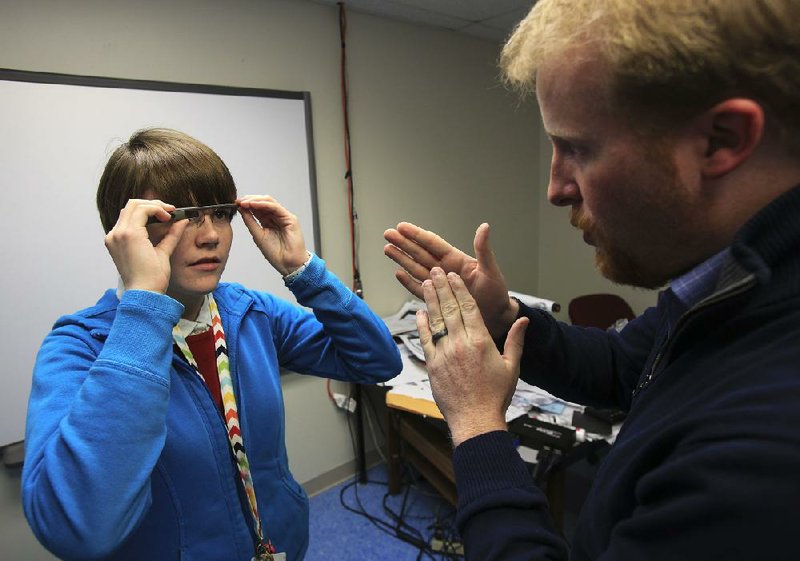Tara Moses, a senior at the Arkansas School for Mathematics, Sciences and the Arts in Hot Springs, suspiciously eyed the device on the table in front of her during a recent conference with the school’s director, Corey Alderdice.
The 17-year-old reached a hand forward, then quickly pulled it back. Alderdice laughed, picked up the new technology piece known as Google Glass and placed it in Moses’ hands.
At first glance, Google Glass resembles a pair of eyeglasses without the lenses. A wire frame circles from one ear to the other, and rubber tabs allow the device to perch on the bridge of the wearer’s nose. That is where the similarities end, however. A piece of hard plastic - with a tiny camera lens - is curved around the right side, stopping just short of the front of the eye, and a rectangular piece of Plexiglas extends almost to the nose.
Google Glass, which is not yet on the market, is a wearable computer that allows hands-free, voice-activated Internet searches; picture and video-taking; and even provides GPS directions as the wearer walks.
The Arkansas School for Mathematics, Sciences and the Arts was chosen as a test site last spring for Google Glass after Alderdice submitted an essay entry to Google’s #IfIHadGlass contest. Initially, only about 1,000 individual users were chosen. Now there are about 8,000 Google Glass Explorers nationwide.
Moses gingerly moved the metal frame in her hand for close inspection before she put on the device. At Alderdice’s instruction, she tapped the plastic side with her right index finger.
“OK, Glass. Take a picture,” she said.
She immediately gasped and stared distantly ahead, transfixed. From her view, a computer-generated image that is superimposed over the real-world view was displayed on the Plexiglas screen.
“Cool,” she said, before excitedly giving the device a string of commands.
Other students at the school have used Google Glass to take pictures of campus life, create video narratives and to record special events - like the school science fair and a singing telegram project.
There is no special checkout procedure for students to borrow the device, Alderdice said. All a student has to do is ask and give the details of how it will be used.
He added that the residential setting of the school makes it easier to keep up with the device among the 240 students.
“One of the things we pride ourselves on here is providing access to technology,” Alderdice said.
In exchange for being among the nation’s first to use Google Glass, the school agreed to supply constant feedback to Google through surveys and online community chats.
“The novelty of being part of something new and contributing to the conversation of something as it evolves is exciting for the students. They are helping to make a device before it goes on the market,” Alderdice said.
Alderdice said one of the biggest drawbacks that he and the students have discovered is that Google Glass cannot be worn over prescription glasses, which limits its user base.
The feedback has been consistent nationally, and Google and the optical industry have responded.
Indiana-based Longe Optical introduced a prescription glass add-on for Google Glass this month. Other optical companies have announced plans to unveil eyeglasses for the device, and photos were reportedly leaked from Google showing what appeared to be an official version of prescription Google Glass.
Students also reported the number of applications that are compatible with the device is limited, and the casing gets a little warm with extended video times. The voice-recognition technology also needs more work on translations, Alderdice said.
He turned to Moses and asked her to Google search“ASMSA,” the abbreviation for Arkansas School for Mathematics, Sciences and the Arts.
Moses tapped the glass and made the voice command. The search result missed its mark.
“You have to use the words rather than the initials. There is no manual input if it is having problems recognizing your words unless it is connected to another Bluetooth device,” Alderdice said.
Alderdice said he believes wearable technology like Google Glass will be the wave of the future. The school plans to use the device more in the spring in its computer-science classes.
“Once Google gets the device in more people’s hands and addresses those needs, it will increase the functionality of it,” he said.
The school and other testers had to purchase Google Glass for $1,500 each. Alderdice said he believes that the price will be a third of that once Google Glass is released to the public.
Google has not announced an official release date for the device.
Arkansas, Pages 13 on 12/29/2013
